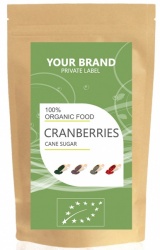Info
CRANBERRIES are a type of evergreen shrub, that have small, dark green leaves, pink flowers, and dark red fruit that are egg-shaped.
They are mostly used for the prevention and treatment of urinary tract infections. But that is not all. They are also used for kidney stones, neurogenic bladder (a bladder disease), to deodorize urine in people with difficulty controlling urination, to prevent urine catheters from becoming blocked, and to heal skin around surgical openings in the stomach that are used to eliminate urine. Some people use cranberry to increase urine flow, kill germs, and reduce fever.
Antioxidants and phytonutrients in cranberries, such as oligomeric proanthocyanidins, anthocyanidin flavonoids (which give them their bright red color), cyanidin, peonidin, and quercetin, have unique health-impacting attributes. (Scientists say it's possible that the anthocyanidin strength in cranberries is increased when they're water-harvested, due to the amount of natural sunlight they're exposed to.) Some contain stroke- and cardiovascular disease-preventing compounds that discourage cholesterol from forming in the heart and blood vessels.
The fiber in cranberries is another big benefit, providing 20% of the daily recommended value in every serving for maintaining a flushed system. The same amount is found in manganese. One serving of cranberries also provides 24% of the daily value (DV) in vitamin C, along with vitamin E (alpha tocopherol), the only form of this powerful antioxidant actively maintained in the human body.
They are mostly used for the prevention and treatment of urinary tract infections. But that is not all. They are also used for kidney stones, neurogenic bladder (a bladder disease), to deodorize urine in people with difficulty controlling urination, to prevent urine catheters from becoming blocked, and to heal skin around surgical openings in the stomach that are used to eliminate urine. Some people use cranberry to increase urine flow, kill germs, and reduce fever.
Antioxidants and phytonutrients in cranberries, such as oligomeric proanthocyanidins, anthocyanidin flavonoids (which give them their bright red color), cyanidin, peonidin, and quercetin, have unique health-impacting attributes. (Scientists say it's possible that the anthocyanidin strength in cranberries is increased when they're water-harvested, due to the amount of natural sunlight they're exposed to.) Some contain stroke- and cardiovascular disease-preventing compounds that discourage cholesterol from forming in the heart and blood vessels.
The fiber in cranberries is another big benefit, providing 20% of the daily recommended value in every serving for maintaining a flushed system. The same amount is found in manganese. One serving of cranberries also provides 24% of the daily value (DV) in vitamin C, along with vitamin E (alpha tocopherol), the only form of this powerful antioxidant actively maintained in the human body.



 NO PARABENS AND PH NEUTRAL
NO PARABENS AND PH NEUTRAL Vegan product,
Vegan product, SELECTED NATURAL
SELECTED NATURAL MODERN production
MODERN production